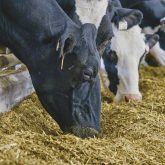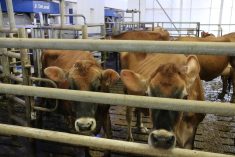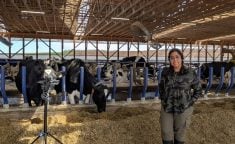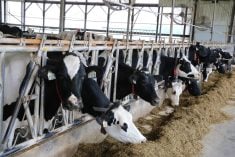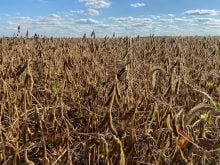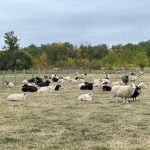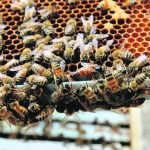Dairy farmers milking in robot systems are increasingly looking at alternatives to one traditional higher energy pellet to feed in the robot, a trend driven by decreasing milk price and increasing milk yield.
Why it matters: Robot milking systems have been operating in Ontario for 20 years, with a growing diversity of feeding management styles as the technology matures.
The milking robots at Christhill Farm near Tara are a good example, with dual feeding systems installed with the first robot about five years ago and the second a year ago.
Read Also

Dissolving eartags could make pig traceability easier
A dissolving eartag for market hogs, called Clean Trace could reduce processing challenges and enable more individual management of pigs.
Trevor Christie, who farms with his parents Jim and Helen and brother Mike, feeds about 2.5 kilograms of pellet and up to 4.5 kg of rolled dry corn mixed with Soyex, the soymeal pressed from the Energrow system, to their top-producing cows hitting 60 kg of milk per day. They were already using an Energrow expeller on the farm to create soymeal for their Total Mixed Ration (TMR).
They grind the corn in the back of their roller mill to break it up and mix it with the Soyex. Straight Soyex was a challenge for the meters in the robot feed distribution system to read properly.
Christie is balancing the challenges of most dairy farmers in this current climate. He’s hoping to decrease his feed costs in the summer by using less pellet, but he’s also trying to keep the herd averaging 38 to 40 kg of production per cow.
About 10 per cent of farmers in the Grand River Robotics service area are trying something other than a pellet in their robots, says Robyn Walsh, who works in farm management support with Grand River Robotics, a Lely dealership.
“With a shrinking milk price everyone is looking for efficiencies,” she said. “Feed is the highest cost on the farm; how do you reduce it?”
The value of a pellet specific to robotic systems is that it is formulated specifically for high palatability, ranging from 16 to 20 per cent protein, says Walsh. The hard pellets handle well through a flex auger, and don’t leave too many fines.
And they can be delivered with no fuss to a hopper by a feed company and metered into the robot.
In a free traffic system, a quality pellet that attracts the cows is an important consideration, says Walsh.
Some are experimenting with a lower-nutrition pellet. Corn gluten pellets have become popular in the United States as a way to lower feed costs.
Corn gluten pellet has little nutrition, says Dr. Nancy Charlton, DeLaval’s dairy advisor (herd management) manager for North America, and when she was in the U.S. recently, it cost an extra $30 per ton to buy a full pellet versus corn gluten. If a farmer is aiming for higher production, then they can’t skimp on nutrition.
High moisture corn a higher-management, but possible option
High moisture corn (HMC) is another alternative, especially if a farm is already set up to use it before they start milking with robots.
“HMC doesn’t tend to flow well through flex augers and small hoppers that feed the robot. So we end up seeing inconsistent feed out if bridging occurs in hoppers, therefore making the cows’ daily diet inconsistent,” says T.J. McDougall, dairy specialist with Parion Animal Nutrition.
The challenge with high moisture corn is that includes that it needs to move through at enough volume that it doesn’t heat or mold, especially in summer, because it is a fermented feed. He says there’s more variability in herds feeding high moisture corn with the potential for higher producing cows to consume more starch then they should.
“High moisture corn in the hands of people who check all the boxes, it can work in their goals. For people who do not check all boxes you can end up with mold and sticking and a less desirable feeding atmosphere,” says Charlton.
She says that farmers who want to feed less pellet can work harder on getting more nutrition from their forages, versus adding more equipment to the system.
The challenge with moving away from feeding full pellets is making sure that cows get enough nutrition in the relatively short time they are in the milker. That’s especially true during the first 100 days of lactation and critical the first 10 days. That’s the time when it’s especially important to get the cows more mouthfuls of non-forage.
Feeding in a robot is all about farmer goals, says Charlton. If the goal is to produce 32 litres per cow, then there are places to cut costs by feeding lower quality feeds in the robot. If they are aiming for 40 litres, then “it comes back to the basics of what makes milk, Dry Matter Intake (DMI).”
Christie was struggling to get enough feed into his cows when they were milking more than 60 cows in one robot, before they added the second. He’s found intake has improved when the cows have more time to milk and to eat. Visits to the robot per day have increased from 2.5 to 3.5 since the new robot was added.
Aiming for higher milk production and especially supporting early lactation cows has resulted in more farmers installing two feed routes to the robot, says Walsh. For some that’s two hoppers and the parallel flex auger systems. For others, it’s a smaller hopper on the top of the robot room with bags of specialty pellets that go into a second system of higher value pellets fed to higher-producing cows.
Christie says they have two separate bins and two separate flex augers that feed the system. He mixes the corn and Soyex feed every few weeks and puts it into a four to 4.5 tonne bin.
At the Christie farm, they figured about a year ago that the dual feeding system helps them to save $5000 to $6000 per year.
“It has definitely paid off,” Christie says.




